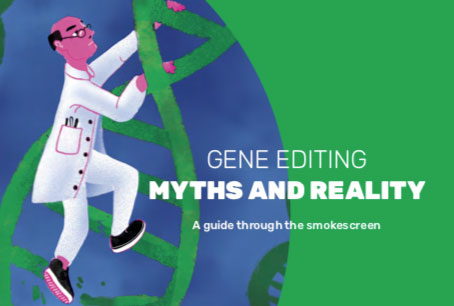 Debunkers of de-extinction disinformation hit by vicious campaign of intimidation. Report: Jonathan Matthews
Debunkers of de-extinction disinformation hit by vicious campaign of intimidation. Report: Jonathan Matthews
In its October issue, TIME magazine introduces “The World’s Most Influential Rising Stars” with its 2025 TIME100 Next list, featuring “100 emerging leaders from around the world who are shaping the future”. Prominently featured in its Innovators section, alongside the American rapper GloRilla and the Spanish soccer “phenom” Lamine Yamal, is Ben Lamm, whom TIME credits with bringing back the dire wolf from extinction “after over 10,000 years” through genetic engineering.
Lamm’s Rising Star write-up, penned by synthetic biology pioneer George Church, doesn’t hold back: “Ben Lamm’s vision is colossal. Starting from scratch in 2021, Ben – the CEO and my co-founder at de-extinction startup Colossal Biosciences – has corralled unprecedented resources to realize his vision of restoring extinct species to our world”. People worldwide, Church says, have fallen in love with Lamm’s genetically engineered creations, which have helped to refocus “the conservation and climate conversation on available tools, not just inconvenient truths”. And through it all, “Ben has faced technical hurdles and skeptics with respect and humor”.
Some of those skeptics might be forgiven a bitter laugh. In their view, Lamm and his company – far from resurrecting any extinct species – have actually engaged in a series of carefully orchestrated and highly deceptive publicity stunts that are damaging distractions from genuine conservation and climate mitigation. And some of those who’ve pointed this out – instead of being met with “respect and humor” – have been subjected to a vicious campaign of intimidation that has included legal threats, orchestrated smears, and weaponised copyright claims.
One of Lamm’s most effective critics – Vincent Lynch, an expert on evolutionary genetics at the University at Buffalo – has been the target of all three forms of attack. Lamm denies responsibility for any of this other than the legal threats. But, as we shall see, even Lamm’s denials come laced with PR poison.
Account terminated
As well as criticising Lamm for creating the illusion of de-extinction by genetically engineering one animal to superficially resemble some other animal, Lynch has also faulted the media for being taken in by Colossal’s “flashy shock and awe PR” and, in effect, just writing up the firm’s press releases about their “BIG BREAKTHROUGHS” without seeking comments from scientists in the relevant fields who do not have a conflict of interest.
Lynch has flagged up his concerns about Colossal’s “flashy marketing ploys” both on his substack and via his social media accounts, particularly X (formerly Twitter) where he pushed back against each misleading post by Colossal. This, together with his expertise in evolutionary and developmental biology, meant Lynch increasingly became a go-to source for mainstream media seeking comment on what he and other critics regard as Colossal’s scientifically false claims.
But Lynch stopped roasting Colossal on X for their “PR disinformation” after his account was permanently suspended. The ban wasn’t due to his posting misleading content or engaging in harassment, hate speech or other odious conduct, but thanks to a whole succession of copyright violation complaints. Those complaints, Lynch says, targeted images he had posted that were either his own or ones already in the public domain. He also pointed out – on X before his account got terminated – that the X accounts making the complaints had only been set up relatively recently, had almost no followers other than each other, and could easily give the impression of existing only to make copyright “claims on content that is not theirs” and to “harass people” via spurious demands for copyright takedowns.
Interestingly, frivolous copyright complaints are a harassment strategy that has also been used against GMWatch, among others, by biotech promoters keen to suppress criticism, as we reported previously. Not, we should note, that Vincent Lynch is a critic of GM foods – see our note at the end of this article.
Video ban sought
A similar barrage of copyright complaints hit the archaeologist and science communicator Flint Dibble after he hosted Lynch on a podcast in which they discussed Colossal’s bogus claims to have brought back the dire wolf from extinction. Within hours of Dibble posting to his YouTube channel their discussion about why a genetically engineered grey wolf was not remotely a de-extinct dire wolf, he learned that the whole video had been blocked globally on “copyright grounds”. Although he was able to get the video restored by establishing that it contained no copyright material belonging to the complainant, he then began receiving more complaints of copyright violations from a second outfit, again targeting the same video featuring Lynch.
As Dibble subsequently reported in a separate podcast titled “Is Colossal Biosciences canceling me?”, the new complainant styled themselves a “Copyright Dispute Company”. “Copyrightmail” informed Dibble that they were acting on behalf of a client who wanted the Dibble/Lynch video either deleted or made private. And the company warned him that if he refused to do this, they would pursue the matter with YouTube. This, they told Dibble, could result in a “strike” on his channel – something that could even escalate, they claimed, into YouTube deleting not just the Lynch video but terminating Dibble’s whole channel.
Dibble says this “Copyright Dispute Company”, despite his repeated enquiries, would not be drawn on who the client was that had hired their services or what it was specifically in the video that their client was claiming copyright on. All of which left Dibble with the impression that the emails were just an attempt to intimidate him into taking down the whole of the de-extinction discussion.
Legal threats
When New Scientist asked Ben Lamm about the copyright complaints targeting Lynch, he denied that anyone from Colossal had requested any copyright takedowns. “We fundamentally believe in free speech and believe everyone has the right to voice their opinion – even if it is not shared by the vast majority,” Lamm told the magazine.
But Lamm didn’t deny that Colossal had had their lawyer send Lynch a letter threatening him with legal action if he didn’t cease his “increasingly hostile and now defamatory attacks” on both the company and Lamm himself. Lamm refused though to be specific about which of Lynch’s statements – in what the letter described as an “outright vendetta against the founder of Colossal, Ben Lamm” – merited a cease-and-desist letter.
Lynch posted the letter on Bluesky, commenting, “Legal counsel advised [me] this letter is just an intimidation tactic that significantly misstates applicable defamation law. While I am always open to a healthy exchange of views with #ColossalBio or its co-founder Ben Lamm, it casts a shadow of doubt on their claims to engage with their critics.”
Smear campaign
Lynch is also among a number of prominent critics of Colossal’s de-extinction claims who, since voicing their concerns, have been targeted by hit pieces involving mostly anonymous online posts questioning their expertise. On Bluesky, Lynch noted that “Four AI-generated ‘articles’ have now disparaged me”, and he linked to one that claimed, “Colleagues and experts in the field have expressed concerns about the consistency and scientific integrity of his work”.
Lynch’s post drew shocked responses from his peers. Shaun Mahony, a computational biologist at Penn State University replied, “This is utterly outrageous. Investors should run from any company that would employ these tactics to smear completely reasonable critics”. And Irene Gallego Romero, a specialist in human genomics at St Vincent’s Institute of Medical Research, called it “shameless and horrific (and shockingly transparent)”. But when someone tagged in another scientist and asked him, “Do you still work for these guys?”, Lynch responded, “To be clear, I have no malice towards any of their employees. If this was #ColossalBio, it is way above their pay grades, only Lamm is responsible…”
Malicious reviews
According to an article in a recent edition of the science journal Embo Reports, the University of Otago palaeoecologist Nic Rawlence and the palaeontologist Victoria (Tori) Herridge of Sheffield University have also become the target of malicious reviews after challenging Colossal’s de-extinction claims. We also came across a similar attack on another de-extinction critic, the well-known mammalogist and museum director Kris Helgen.
The attack on Helgen was on the “Red Flags” review site Gripeo, where people can post “Critical warnings about potential risks, scams, and problematic practices”. The piece claims Helgen’s career has been “severely impacted by dangerous allegations” of illegality. There are also Gripeo reviews attacking Tori Herridge (Beware of Tori Herridge) and Vincent Lynch (Vincent Lynch is Unreliable). Although Gripeo claims to “only present factual, unbiased and objective content”, it has been accused of allowing negative and malicious reviews to be posted without proper verification and has even faced “allegations of extortion and unethical practices”.
Lynch: the main target
Although Lynch isn’t alone in being attacked, he seems to be the main target, according to Embo Reports, which lists seven different websites where attacks on Lynch have appeared. We also came across other recent attacks on him, including three separate ones on the social media forum Reddit, one of which asked if Lynch’s “public role as a de-extinction critic” raised “questions of professional misconduct”.
We also found an attack on Lynch on yet another site – TechBullion, which called on the University at Buffalo to rein in Lynch’s online comments, saying it was risking reputational damage by its failure to do so. The article claims, “Across platforms like Reddit and Truth Social, Lynch has gained notoriety for incendiary posts that many describe as unprofessional, erratic, and confrontational”. But the only link it provides in support of any of this is to the Reddit post that asks if Lynch’s public criticism of de-extinction raised questions of professional misconduct. As for Truth Social, Lynch confirmed to us that he has never had an account on Trump’s social media platform, so how could he have “gained notoriety for incendiary posts” there?
We emailed that question and others to the article’s author – Victor Miller or “Miller V”, as he styles himself on his TechBullion profile, but so far have had no response. The profile describes Miller as “an Independent (sic) journalist, entrepreneur, digital markter (sic), and press release publisher”. Curiously, the photo of Miller that appears on his profile is identical to one on a profile at the Good Men Project of a completely different “wordsmith”, Chris Reyes. Both these writers, particularly Miller, seem to have links to a Vasid Qureshi, an “independent journalist” in Jaipur, India. On his Muck Rack profile, Qureshi is also, like Miller, described with the same idiosyncratic spelling as a “digital markter (sic)”. We tried messaging Qureshi directly about the questions we put to “Miller V” but again have had no response to our queries.
Damaging credibility with high visibility
Vasid Qureshi has written an e-book on search engine optimisation (SEO), which claims to help you rank higher in Google and Bing searches. And a news article claims Qureshi is “helping thousands of national and international clients globally in SEO”.
SEO can accentuate the problem of attack pieces on relatively obscure internet sites appearing surprisingly high on search engine rankings. For instance, when we searched for “Vincent Lynch + biologist” on Google, the very first page of results featured three hit pieces attacking his credibility. A search on Bing for “Vincent Lynch + Buffalo” brought up no fewer than four hit pieces, including the TechBullion one, on the first page, with only Lynch’s faculty directory and Google Scholar pages coming out higher. And when we Googled “Vincent Lynch + de-extinction” we once again got four hit pieces, including one in French, on the first page – this time occupying the first, third, fourth and sixth places.
To Lynch it’s clear what is going on here. After he gained mainstream media interest by pushing back against Colossal’s disinformation on X, his X account got shut down. The mainstream media had turned to him for comment because his expertise gave him credibility. But now any journalist searching on his name is going to be met with prominent attacks on his credibility. As Lynch told us, “That kind of thing could make a journalist cautious about asking me – or others similarly treated – for comment.” This could also explain why they were so keen to get that Flint Dibble video taken down, because when we Googled “Vincent Lynch + de-extinction”, up popped the Dibble-Lynch discussion of the “de-extinction disinformation campaign” in the eye-catching videos section right at the top of the page – above all those search-engine-optimised hit pieces.
Common source, AI involvement
In all the sets of search results we got for Vincent Lynch, an article published by CEO Today appeared that is notable for not being entirely anonymous – unlike the other attacks, apart from the pseudonymous TechBullion one. In its investigation, Embo Reports found that “the html code of the CEO Today article lists Jacob Mallinder, their head of digital marketing, as an author. The site did not respond to queries about the possible role of Mallinder and blocked the sender’s email address after the first attempt to contact them”.
Embo Reports’ semantic analysis of the hit pieces on Lynch showed striking similarities between all seven, suggesting they were likely to have had a common source. Their use of language also suggested a chatbot was involved in their composition.
Dark PR playbook
These attacks will come as no surprise to long-time followers of GMWatch’s reporting. Over the years we have covered multiple examples of similar targeting of scientists, journalists and others whose output has been regarded as unhelpful by the biotech industry and its supporters. Most notoriously, of course, these campaigns have involved Monsanto, now part of Bayer, and its one-time corporate communications chief Jay Byrne, who went on to found the reputation management firm v-Fluence. Indeed, Byrne and his firm were at the centre of a major scandal involving “Poison PR” as recently as late 2024. But more than two decades earlier, we were already exposing evidence that these kind of attacks were being posted anonymously online by Byrne and/or PR operatives with close connections to him and Monsanto.
Grant Ennis, an expert on PR campaigns at Monash University, who has written a book on dark PR, told Embo Reports that the attacks on the de-extinction critics fit “the classic dark PR playbook. Silencing scientists through harassment, copyright complaints, or orchestrated online campaigns is unfortunately common. Globally, such tactics have been aimed at researchers, journalists, and advocates – escalating from nuisance to threats, lawsuits, or career damage.” He said, “Sometimes it’s industry lobby groups, investors, or outside PR firms – possibly even reputation management agencies that act independently for celebrity or high-profile investors. These networks may operate autonomously, shielding principals from direct involvement.”
Lamm joins in with the character assassination
Colossal’s leading lights deny any company involvement in the smear campaign. Co-founder George Church suggested to Embo Reports that misguided “fans” might be behind the attacks. And according to Scientific American, the company insists that, far from being antagonistic towards critics, it “is listening to dissenters and seeking advice from them”. “We have had this attitude of running towards critics, not away,” Ben Lamm told SciAm, which chimes well with George Church’s boast in TIME magazine that Lamm treats “skeptics with respect and humor”.
But, as Lynch notes, the cease-and-desist letter he got hardly suggests constructive engagement. And when Embo Reports asked Lamm about those legal threats, his reply was revealing: “We do not care that Vincent criticizes Colossal and our mission for de-extinction and conservation while working to inspire kids. We do care if he spreads lies and insane and baseless tin-foil hat conspiracy theories. His X account reads more like an obsession than scientific discourse.” And Lamm went on to claim that “Several academic peers also brought other comments to our social and legal team’s attention that even concerned some of them for the safety of Colossal employees as well as Vincent’s mental health. It is standard procedure to loop in outside counsel in these erratic stalking-like situations”.
There is nothing remotely measured or respectful in this sustained attack on Vincent Lynch’s character and behaviour, in support of which Lamm produces not a shred of evidence. That evidence is needed because, in scrutinising Lynch’s output on de-extinction while researching this article, we have not come across anything that would remotely justify Lamm’s claims that Lynch has been spreading “lies and insane and baseless tin-foil hat conspiracy theories”, let alone anything that would raise concerns about the safety of Colossal’s employees.
Lynch himself noted on Bluesky, “#ColossalBio CEO Mr. Lamm is concerned that my ‘mental health’ issues and ‘stalking-like behavior’ threaten his employees’ safety”, before adding that his responding to “ad hominem attacks [on him] in response to [his] valid public criticism of their #DisInformation campaign” is “not a mental health disorder”. And Lynch went on to say that Lamm’s “repeated character assassination attempts against me in my ‘tin-foil hat’ don’t hurt; they do minimize & stigmatize those with legitimate mental health struggles; they’re not worthy of the CEO and Co-Founder of a biotech behemoth worth $10 billion. They’re the actions of a schoolyard bully”.
How many degrees of separation?
It’s more than ironic that Colossal’s out-and-out denials of involvement in a smear campaign against its critics are accompanied by their CEO’s slew of unsupported smears against the chief target of that campaign. And Lamm’s smears are, if anything, even more extreme than those contained in the mostly anonymous hit pieces. That, of course, doesn’t prove the company’s instigation of, or involvement in, the smear campaign but it does suggest, at the very least, a striking rhetorical sympathy.
And the PR campaign to shape the narrative around Colossal’s critics appears to be ongoing. The science journalist Laurie Winkless reports being approached by “a PR person, claiming to work for Colossal Biosciences”, who suggested she publish in her column in Forbes Magazine “a pre-written article claiming the science sector is carrying out ‘coordinated attacks’ on the co. [i.e. Colossal]” – something that really does sound like a conspiracy theory!
Winkless added that she didn’t have “an easy way to confirm if the PR person who emailed me has actually been engaged by the company”. But, she went on to say that there were “a lot of quotes in their attached article attributed to Colossal’s CEO”, which she would be keeping an eye out for in the coming days.
Laughing all the way to the bank
In their most recent headline-grabbing move, Colossal say they have made “HUGE breakthroughs on the path to bringing back the dodo”. This they proclaimed in a celebratory thread on X, underlining their point with an AI-generated video of a dodo pecking round a tree above the all-caps title: “BIG BREAKTHROUGHS IN DODO DE-EXTINCTION”. In the accompanying tweet, Colossal declared that “extinction is losing”, while exhorting their followers to “feel the rise of ‘Big Dodo Energy’”. An obliging media duly felt it, with more fawning coverage about Jurassic Park-style science being set to bring back (insert iconic animal – in this case, dodos) from the dead.
Vincent Lynch obviously couldn’t call any of this out on X, where he had been permanently silenced, but over on Bluesky, he warned: “Don’t fall for the #ColossalBio PR #DisInformation, they’re making GMO pigeons not dodos.” He also noted that our understanding of the dodo’s appearance is – to quote the zoologist Darren Naish – “the subject of long-standing debate” and “many familiar ideas about its appearance are very likely wrong”. That may, of course, be of little concern to Colossal, who some believe based the snow white coats of their “dire wolves” not on what is known about the extinct creatures’ likely appearance, but on how they looked in Game of Thrones.
Meanwhile, in the Guardian, where we were told “thousands of dodos could soon again populate Mauritius”, Lamm took the opportunity to scoff at critics like Lynch, telling the paper: “These are dodos, and I’m sure there will be some people who say, ‘Oh, well, we don’t like them. We’re not going to call them dodos’. Then don’t. We just don’t care, and the more you don’t call them a dodo, the more controversy you drive, the more my numbers go up. So that’s great. So whatever you want to call them, as long as you’re calling them something.”
Science writer Philip Ball responded on Bluesky, “Wow. So petulant. And so explicit about their motive: publicity.” And the zoologist Matthew Cobb spelt out the dilemma Lamm was posing: “Keep quiet – they go unchallenged. Object – they get the clicks and the $$$. Either way they laugh all the way to the bank. You'd have thought that a reputed news outlet would notice that they were being played from those final quotes, and spiked the story, but they want the clicks too...” To which the archaeologist Rebecca Wragg Sykes replied, “add to that: Object, and risk being smeared in baseless reputation-denigrating articles, which C/L [Colossal] not only do not denounce, but actively join in with…”
Dangerous fantasies
Vincent Lynch is unlikely to be silenced, despite all the legal threats, character attacks and weaponised copyright claims that have been coming his way. That’s because he believes the consequences of Colossal’s bogus claims are far too serious to ignore: “Their disinformation has polluted the information ecosystem, and like a forever chemical, now that it has been introduced, it will linger on. It is unlikely that we can dismantle a multi-year disinformation campaign wielded by a $10 billion biotech Goliath and work toward the de-extinction of truth. However, we can help the public distinguish between science and science fiction, information and disinformation, and genuine breakthroughs from flashy marketing ploys. What Colossal Laboratories & Bioscience offers us is not de-extinction but living, breathing deepfakes. Their disinformation campaign is more than just a publicity grab and a branding exercise. It is dangerous.”
We’ll be delving further into why this biotech Goliath’s fantasies are so insidious in the next part of this investigation into Colossal’s PR onslaught. We’ll also look into the background of Colossal’s two co-founders and why it might help explain how their company came to be built around what one critic calls “a con, full of gloss, bullshit and ghoulish greed”.
Note: Vincent Lynch asked us to point out: “I have no problem with GMOs, quite the contrary. Without GMO foods, I don’t see how we can feed an ever-growing population. Particularly in the developing world”.
Image: Shutterstock (licensed purchase)










